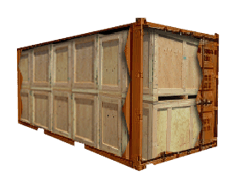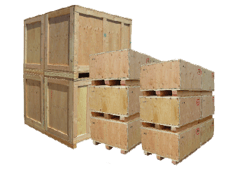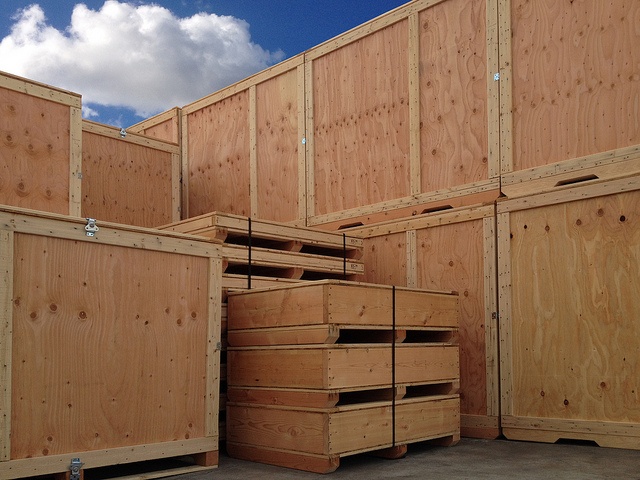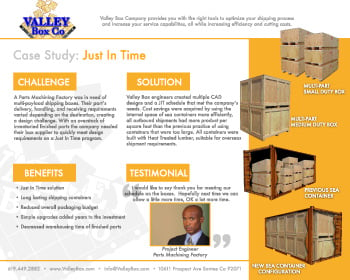One of the biggest challenges manufacturing companies face today is waste—wasted time, wasted materials, wasted inventory, wasted space, and wasted man hours to name a few. Fortunately, there are a number of ways to minimize or even eliminate waste—especially when products are ready to be shipped. One proven method is custom crates combined with a Just In Time program.
The following Valley Box Company case study is a prime example of how these combined strategies can minimize waste and maximize savings—even on a tight schedule.
Challenge: Too many crates to choose from and keep in inventory
A Parts Machining Factory was in need of multi-payload shipping crates. They manufactured multiple sized parts with varying shipping methods and had multiple crate designs to accommodate each unique product and customer. After an internal evaluation it was determined that this method was causing:
- Wasted Floor Space In order to take advantage of quantity breaks they often had an overstock of crates.
- Wasted Labor Employees would often start with the wrong crate, when it was too small they spent time re-packaging.
- Wasted Capital Remember the employee that used the wrong crate? When it was too big it was shipped anyway and the company had to pay freight on the extra square footage.
- Wasted Time Due to all the sizes the Purchasing department had to spend a lot of time organizing the part id's on PO's.
With an overstock of inventoried finished parts, the company needed a crate manufacturer who could quickly meet design requirements on a Just In Time (JIT) program.
Solution: Reduce the number of package options with custom crates delivered on a JIT schedule
 Valley Box engineers successfully reduced the total number of crate part ids by analyzing all the company's parts dimensions and shipping requirements (sea container and truck and trailer). After several design revisions a small handful of standard sizes were created to handle the unique parts and shipping methods. All the custom crates were heat treated to meet overseas shipping requirements. Cost savings were acquired by using the internal space more efficiently.
Valley Box engineers successfully reduced the total number of crate part ids by analyzing all the company's parts dimensions and shipping requirements (sea container and truck and trailer). After several design revisions a small handful of standard sizes were created to handle the unique parts and shipping methods. All the custom crates were heat treated to meet overseas shipping requirements. Cost savings were acquired by using the internal space more efficiently.
 Once the standard sizes were developed, Valley Box was able to work with an order forecast to establish a Just In Time program. Valley Box built to an internal stock to a pre-determined min/max. When the Parts Machining Factory needed crates they placed the PO and received the crates next day. This practice allowed the Parts Machining Factory to regain valuable floor space by not carrying on-hand inventory. It also reduced the confusion which lead to errors by employees using the wrong crate to package because there were fewer crates overall to choose from.
Once the standard sizes were developed, Valley Box was able to work with an order forecast to establish a Just In Time program. Valley Box built to an internal stock to a pre-determined min/max. When the Parts Machining Factory needed crates they placed the PO and received the crates next day. This practice allowed the Parts Machining Factory to regain valuable floor space by not carrying on-hand inventory. It also reduced the confusion which lead to errors by employees using the wrong crate to package because there were fewer crates overall to choose from.





